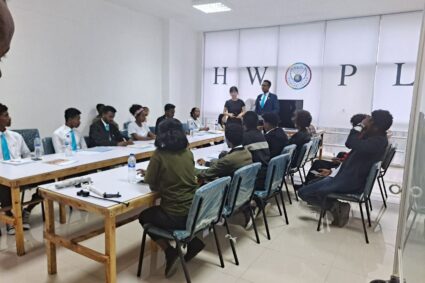
by Mesleche Zelalem Kiddus

African women Journalists ; African Women Authors
The ups and downs of female journalists and writers
Dear Readers, First of all, I would like to apologize to the readers of the recent article on the press, especially to remind you that there is an error in the timeline of the Ethiopian press, and that the error can be determined by calculating the time of the press.
Women and the media are involved in television, newspapers, magazines, books, cartoons, public relations and advertising. For example, how many women are in The Reporter’s (Amharic and English) editorial department? More than 50 percent of them are women. Therefore, we find that this section of the newspaper is much larger than other newspapers and magazines. Next, we will find a number of journalists and women related to journalism in a new and new era. However, in the New Era, editors, reporters and other journalists are not aware of the fact that there are many female journalists, designers, photographers and professors. She is also the editor-in-chief of Zemen Magazine and may be the first female editor-in-chief. The manager of Addis Admas newspaper is a woman, and the owner of Queen’s Magazine is a woman. In addition to the newspapers and magazines mentioned, they are still on the market today, but men like Menelik, Salem, Efoita, Tobias, Mizan, Horn of Africa, Muday, Mind, have been involved in women’s journalism and journalism. Their involvement in the electronics sector, especially radio and television, over the past 50 years has not been easy. The main purpose of this article is to look at women in the media, from a variety of perspectives, first and foremost, to understand what the media is, women’s participation in various parts of our purpose, the status of women’s participation in our country, and the magnitude of our problems. The author of this article would like to point out that the foreign experience added here is intended to show where our women’s participation should begin.
International Women’s Participation in the Media
When we say women and the media, we mean women’s participation in books, newspapers, magazines, cartoons, television, radio, public relations, and advertising, and we start with books, as they are the first book, magazine and newspaper. Numerous books on female authors tell us that women have been involved in the writing of books, poems, short stories and long stories for more than two thousand years. In fact, Lisa Tutl writes in her encyclopedia of feminism (1986) that her involvement in poetry, one of the most important aspects of poetry, dates back to the beginning of her own poetry. The author of this 400-page workshop said: It was a time when they showed that they were not inferior to them before they were created with a narrow throat to control what they should and should not say, ”he said in particular in his section on Poetry and Poetry.
Bloomsbury published a book entitled “Women’s Literature”. In his 1172-page book, published in 1992, he wrote extensively in ancient Greece, Rome, Britain from 15th to 20th century, as well as in various European, African, Australian and Asian countries, as well as in North and South America. According to the book, only men wrote until the fifth century BC. Since the fifth century, however, women have been known to excel, especially in poetry. During the fifth to fourth centuries, women were given the opportunity to read literature while training in home administration. This increased their chances of participating in this field. From the fourth century to the second century BC, love poetry was even considered a major introduction to women’s emotions. Participation spread not only in Greece but also in ancient Rome.
It is well known that there were many female scribes in Rome between the first century and the fifth century BC. Among the early Roman women writers were the first and second Sulpicia. Sulphia I was from the first century BC to the first century AD, and she wrote poems on various topics. Like Sulpicia, there were female writers such as Hor Tessia, Sicily, and Cornelius, and by the end of the fifth century BC their political and economic influence had increased, and their literary influence increased. Just as women were involved in the literary world in Europe before Christ, so they did in Asia, especially in Israel, India, Southeast Asia, Japan, and China. Although European and Asian women writers are said to have played a major role in the field of literature since ancient times, European scholars tell us that Africans and literature became acquainted with colonialism. But we know that in Ethiopia and the rest of Africa, our mothers write poems for weddings, mourning, war and other social issues.
It should be noted that the history of women’s participation in literature has been growing since the invention of the printing press. But why are there so few female writers when the world is both male and female? In her 1928 article, Erum of One Own, Virginia Wolf emphasized that women should have their own income and their own home in order to write on an equal footing with men. Virginia has also been affected by the portrayal of female characters as weak, impotent, in need of entertainment and care, and sexually active. It is important to remember that in the pre-Virginia era, there was a strong movement in the UK to eliminate the stigma attached to women and to protect women’s right to vote and stand for election. Prominent leaders include Professor Pankhurst’s grandfather Emlyn Pankhurst (1858-1928) and his mother, Sylvia Pankhurst (1882-1960), Emily Davis (1830-1921), Elizabeth Garret Anderson (1836-1917), and Lydia Harvest (1827-90). The reward of his reward. It should be noted that in the 18th and 19th centuries some women writers wrote in the name of men. On the other hand, it is a fact that women are not involved in the work of a newspaper, let alone their closeness to journalism.
Helley Blaise, better known as Elizabeth Cochrane Simon, was published in the 1965 book “New Survey to Journalism” by Dr. Fox Macha, for the sixth time. He mentioned that he was one of the leading journalists (1867-1922). These have paved the way for the emergence of veteran journalists such as Dr. Thompson, Ishbel Rose and Anhar McKarmick. It is worth noting that these leading journalists were ridiculed for their masculinity, witchcraft, and persistent prayers. Instead, it was not easy for women in their day to learn the art of saving, even if it was a widow or an artist. Because it was not a joke, men were given the lead in doing the hard work, such as advertising. It should also be noted that the demand for men was secondary. Fortunately, advertising led to a step-by-step approach to writing, which enabled them to produce commercial newspapers and magazines. Later, in most daily newspapers (large and small) they started talking about fashion, medicine that could be prescribed by a doctor, young people who had been abducted by their loved ones, child rearing, family and community, home decoration, gardening and so on.
In his 1951 book, Journalism and Student Journalism, Frederick W. Maguire, an associate professor of journalism at Ohio University from 1943-44, states that the establishment of a student newspaper will serve as a cornerstone for those on this path in life. . Not to mention the increased participation of women in newspapers and magazines, emphasizing that training young people in this profession will enable them to discriminate and respond to public demand, not to mention the increase in the popularity and demand of newspapers and magazines. Its desirability and readability put them at a level of ordinary participation and responsibility. Dr. Foxxmot’s college textbook confirms that out of the 131 daily newspapers published in the United States, 121 publishers, presidents, managers, or editors were women. It is hard to imagine a newspaper in the United States, Europe, Asia, or Africa today that would not allow women to participate. Although women have been excluded from the media for many years, it is now widely accepted that the purpose of newspapers and magazines cannot be achieved without women’s participation.
Summary of the Press and Women’s Participation But before moving on to electronic media, Ray Elden Hebert’s book, Mass Media, published in 1992, stated that the Women’s Equality Movement owns print media rather than electronic media. It is important to note that it has been used more, that print media is less expensive than electronic media, and that they are more trained in print journalism than radio and television journalism. ” When we look at the participation of women in electronic media, especially radio, since its inception in the 1920s, we see it in the context of newspapers and magazines. Women had the experience of expressing their opinions in newspapers and magazines, and as radio programs spread during World War II, they began to participate in advertisements and dramas, and then on housewives, programs, and so on. In addition, I would like to point out that women’s participation in the radio industry began to increase after the establishment of several radio stations in the 1930s.
Radio programming reached its peak in the 1940s, and television was booming at the time. Women’s participation in this media was not exaggerated. After 1948, however, many television stations were able to establish themselves and many television journalists took part. According to Professor Ray Eldon Hibbert in his book Mass Media, human rights were not really what it used to be. After the 1960s, especially after the expansion of radio and television, they worked not only as editors but also as responsible. When it comes to radio and television, we should also talk about filmmaking and women’s participation. I don’t think it’s important to focus on radio and television without getting it right. However, I would like to mention the media and the participation of many women in this field.
Women’s participation in the media
When did we talk about Ethiopian women’s participation in the media and when did women start participating? What media have we used since? Must be answered. Dr. Amsalu Aklilu, who teaches Ethiopian literature on the history of Addis Ababa University. Their work is about male writers, not about women. In the world of writing, if there is a woman who wrote a poem, why did the writings of an Ethiopian woman disappear from the pages of Ethiopian literature? Have women ever written poetry, short stories, articles, long novels, or even a little on the radio and television? It makes us ask. According to Abaynesh Birru in her article “Women’s Issues in the Media”, compiled reports, especially since the publication of books and newspapers, have been published in 1966 by Jonas Admasu, Habte Mariam Markos, Yohannes Admasu and Hailu Fulas. A.D. He has written extensively on the history of Ethiopian literature. They did not forget that Debtera Zeneb was a man of the Tewodros era. But,
“You could not pull one leg of pepper,
Let the fire burn for you.
A thousand horses in front of him, a thousand horses in front of him
A thousand iron in the back, a thousand iron in front of him
Her mother died without seeing this.
When he heard this, he sighed
If they ask you who it is, say it is beautiful. ”
The poem Mentewab Chakol (1857) is not mentioned in the history of Ethiopian literature, except for the fact that it is a play. We learn from their literary history that the history of the ancient Greeks, Romans, and the Far East is reminiscent of the beautiful. However, before the writing of women in most African countries, we see that Ethiopian women have been living in the world since 1941. In its third book, The Oxford Company to Theater, without mentioning the two university literature textbooks, it states: “In addition to wheat, she received a book in 1974 entitled Romanwork Kassahun Mahtote Tibet.” The reward of his reward. Although these books may not be suitable for university teaching, it is not clear why they are not mentioned as such. In addition to the two writers, Mengistu Mekonnen published a book (1950s) advising couples not to commit adultery under the title “Albergo’s Philosopher”.
It is well known that in our day there are women who have written and translated short stories, poems and long stories. Tsehai Melaku, who wrote “Enguzna” Qasa “, Weinshet Masresha, Azeb Girma Wolden, Mary Jafarse, children’s books and poems by Enalem Tsehai Weda. Today, there are many short stories and poems written in newspapers, magazines and books. Jemaneh has a bachelor’s degree in Ethiopian literature and is currently pursuing a master’s degree in the field. So, I think anyone who wants to do research on women writers can get an idea by looking at these works.
Their involvement in newspapers
It has been published in our country since the Italians began publishing in alms in 1874, both directly and indirectly. Published in French and Amharic in Harar since 1893, “Le Sumir da Ethiopia” has been published. Then there is the newspaper “Mind”, which has been published since 1895. After 1920, newspapers such as “Light and Peace”, “Kesate Birhan” and “Local Star” were published. During the Italian invasion, the Patriots had a newspaper called “Our Flag” and the Italians had a “Roman Light” newspaper. Since 1933 Our “flag” newspaper has since been replaced by an Arabic and Amharic newspaper entitled “Our Flag”. Addis Zemen, Today’s Ethiopia, Voice of Ethiopia, Union, as well as Menen, Mirror, Ethiopian Observer, Addis Reporter, Revolutionary Ethiopia, February, and Sendek. Many women participated in writing and advertising in these newspapers and magazines. In addition, there are magazines published in every government office. Although many of these magazines are blinking, it is difficult to study, but the police, the action, the armed forces, the news tourism, and so on.
But when we look at all the women who started participating in newspapers and magazines, we know that he is 70 years old. This is a short biography of W / ro Mekdes Work, especially in our 1940 edition. According to the newspaper, she is the author of a book called “Professional Source”. I received information from 1940, but it is hard to imagine that women’s issues would not be mentioned occasionally, even if it were not a series, since the publication of the New Age and Our Flag newspapers. 1945 In the students’ column, the Lady of Thousand, Miss Caleb Asmara in 1946, and Roman Work Kassahun in 1945 performed “Poetry Night”. Sylvia Pankhurst, also known as Wolete Selassie or a similar Christian name, has been involved in the Ethiopian Herald since its inception. We do not think that this woman has neglected women’s issues because she has been fighting for women’s equality from her mother’s lineage.
In addition, Menen and Mirror magazines published photo reports and advertisements on women’s fashion, women’s music, and our people. For example, in 1942. Women’s Mirror in Printed Menen, 1954. We find a women’s page on Menen. In the same 1954 edition, an article was published on the participation of female radio journalists. When we look at today’s Ethiopia, the Voice of Ethiopia, the Union, the working class, the revolutionary Ethiopia, the February and the flag, and the newspapers and magazines that have been published since 1983, we find many women. At the beginning, there were magazines called Heaven and Eve.
Radio participation
When Ethiopian women started participating in radio, Abaynesh Birru was born in 1984. It is unknown at this time what he will do after leaving the post. According to her estimates, however, since 1959. It’s too early. However, “Ethiopian Radio and Television’s weekly program, which airs from January to August 1957. The old roster confirms that on Monday morning there were programs such as Widows, Family Life and Childhood Advice, Sickness, Women and Careers. In addition, in 1954. We know that there were also female editors who published radio magazines. This women’s program has been around since 1957. It indicates that it has already begun. Roster also posted a photo of her reading, “Esther Moges, a student of Ethiopian Radio Training.” However, since the history of women’s participation in radio dates back to the beginning of news and programming, not the history of radio and television, as in music, drama, and commercials, patriotic theater is likely to be one of the leading events in this field. In fact, when it comes to the history of Ethiopian radio newspapers, the history of the station itself should be considered. According to the March 1987 issue of the first year of issue 1, the language of advertising, radio broadcasting began in 1928. it is. When Italy invaded our country, it set up a radio station to broadcast its programs. 1933 Even after our country gained its independence, radio service was better organized. Efforts have been made to improve this organization in 1946, 1949, 1952, 1955 and since. 1928 It is known that the Empress was speaking when our country was invaded by Italy. So why should women’s participation never start with the Empress? By the way, it’s the king’s speech. In 1957, the then Director General of Ethiopian Radio and Television reported that he had participated in the station’s broadcasting program, in particular the “Discussion is Good” program. Since then, not only women, but also female programmers, Roman Work Kassahun, Eleni Fetene Journalism, Nesopia Yilma, Tabota Wolde Michael, Eleni Mukaraba, etc. have been involved.
Participation on Ethiopian Television
Ethiopian Television October 23, 1957 According to the three-month weekly program, it was held every Thursday from 2:15 to 2:45 p.m. This ensures that women’s participation on Ethiopian Television begins immediately. According to a study by Abaynesh Birru, “Ethiopian Television’s Women’s Memory Program begins in 1966. In the years to come. ” Even so, news outlets such as Eleni Mukaraba have been working since 1966. We remember that they were before. During this time, women were seen participating in foreign advertisements and films, so he encouraged our women to participate in this regard. The beauty pageants, doctors, officials and soldiers were seen on television at the time, attracting the attention of presenters such as Genet Berha, Mulu Tsehai Bogale, Bzu Wondemagenehu, Sahle Mariam Beyene.
Especially since the 1970s. Later, the number of women in the program grew as a programmer, reporter, advertiser and filmmaker. Today, in addition to Amharic and English, Oromo, Tigrigna, Afar, Somali, etc. programs have been launched and the number of candidates for these programs has increased to thousands. This is encouraging given the fact that access to female reporters, editors and advertisers has been a challenge for the past two decades.
Public relations
As mentioned in the introduction, public relations is the media sector. Therefore, all women in public relations write articles for newspapers, radio, television, magazines, and brochures. They do film and photography. They create a conducive environment for press conferences or interviews. In addition to public relations staff, there are also foreign news agents.
Current evidence suggests that until recently (1983) the majority of women in various presses had completed high school, with a few graduating with a bachelor’s or master’s degree. Since 1991 In recent years, however, many female journalists have become proficient in journalism and journalism at Addis Ababa University and other universities. Participation in various press releases is also encouraging. However, efforts should be made to study women’s participation in private and public newspapers, radio, television, advertising, film, amateur newspapers and writers’ clubs, public relations departments, and to provide information that will satisfy future generations. In this regard, there is no doubt that studies for graduation or postgraduate studies are prepared in a way that is suitable for newspapers, magazines and books. Despite the growth of the media since 1983. It continues to flash. The biggest problem now is not the lack of press law or censorship. The law of the press will be amended, the freedom of the press for various reasons will not be hindered, people will be able to write, speak and express themselves without embarrassment. Instead, it will play an important role in increasing women’s participation in the media. The basic reason for media freedom is that the press serves as the eyes and ears of the government and the people. In fact, the press often exposes the shortcomings of the government, and some may think it harms the government and the people. But if there are mistakes that the government and the people do not realize, it will help them to correct the mistakes in time and not hurt them. So, even if the press strongly criticizes and condemns the people and the government, accepting its criticism and condemnation is correct, not a failure. Still, to what extent has the press used reality to build a culture of democracy?
In fact, the biggest problem today is the inability of some private media outlets to distinguish between news and novels. If a novel is published in the news, a free press cannot be used to flourish democracy. The problem with the press and some opposition parties is that they have to be able to measure the role of these groups in Ethiopian politics in one way or another. If the press is to be heard, the only option is to move in the community. Otherwise, the application will not be able to play an important role in the Ethiopian political arena. Democracy cannot exist as long as the Ethiopian people do not respect it and the ultimate proponents of justice are foreign individuals or human rights organizations. Possibly a special colonial desire. Unaware of this, some private presses have been able to play a constructive role in the past few years. But this does not mean that there is no hope for the future. When a generation comes to realize that it is the press’s turn to act in a constructive manner according to the law, it will no longer be monopolized by individuals who want to use it for creative, anti-peace and anti-development purposes, and there will be constructive press and criticism of the government. Women’s participation will also increase.












